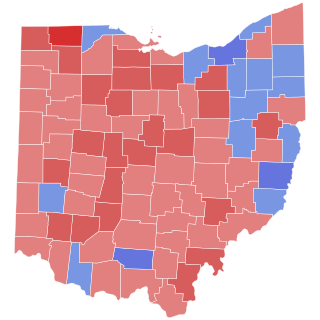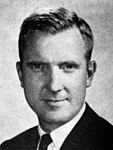
John Joyce “Jack” Gilligan was an American Democratic politician from the state of Ohio who served as a U.S. Representative and as the 62nd governor of Ohio from 1971 to 1975. He was the father of Kathleen Sebelius, who later served as governor of Kansas and United States Secretary of Health and Human Services.

Stephen Marvin Young was an American politician from the U.S. state of Ohio. A member of the Democratic Party, he served as a United States senator from Ohio from 1959 until 1971.

The 1988 United States Senate elections were elections for the United States Senate. Held on November 8, the 33 seats of Class 1 were contested in regular elections. In spite of the Republican victory by George H. W. Bush in the presidential election, the Democrats gained a net of one seat in the Senate. Seven seats changed parties, with four incumbents being defeated. The Democratic majority in the Senate increased by one to 55–to–45.

The 1986 United States Senate elections were elections for the United States Senate. Held on November 4, in the middle of Ronald Reagan's second presidential term, the 34 seats of Class 3 were contested in regular elections. The Republicans had to defend an unusually large number of freshman Senate incumbents who had been elected on President Ronald Reagan's coattails in 1980. Democrats won a net of eight seats, defeating seven freshman incumbents, picking up two Republican-held open seats, and regaining control of the Senate for the first time since January 1981. This remains the most recent midterm election cycle in which the sitting president's party suffered net losses while still flipping a Senate seat.

The 1980 United States Senate elections were held on November 4, coinciding with Ronald Reagan's victory in the presidential election. The 34 Senate seats of Class 3 were contested in regular elections. Reagan's large margin of victory over incumbent Jimmy Carter gave a huge boost to Republican Senate candidates, allowing them to flip 12 Democratic seats and win control of the chamber for the first time since the end of the 83rd Congress in January 1955.

The 1978 United States Senate elections were held on November 7, in the middle of Democratic President Jimmy Carter's term. The 33 seats of Class 2 were contested in regular elections. Special elections were also held to fill vacancies.

The 1974 United States Senate elections were held on November 5, with the 34 seats of Class 3 contested in regular elections. They occurred in the wake of the Watergate scandal, Richard M. Nixon's resignation from the presidency, and Gerald Ford's subsequent pardon of Nixon. Economic issues, specifically inflation and stagnation, were also a factor that contributed to Republican losses. As an immediate result of the November 1974 elections, Democrats made a net gain of three seats from the Republicans, as they defeated Republican incumbents in Colorado and Kentucky and picked up open seats in Florida and Vermont, while Republicans won the open seat in Nevada. Following the elections, at the beginning of the 94th U.S. Congress, the Democratic caucus controlled 60 seats, and the Republican caucus controlled 38 seats.

The 1970 United States Senate elections was an election for the United States Senate. It took place on November 3, with the 33 seats of Class 1 contested in regular elections. Special elections were also held to fill vacancies. These races occurred in the middle of Richard Nixon's first term as president. The Democrats lost a net of three seats, while the Republicans and the Conservative Party of New York picked up one net seat each, and former Democrat Harry F. Byrd Jr. was re-elected as an independent.

The 1968 United States Senate elections were elections for the United States Senate. Held on November 5, the 34 seats of Class 3 were contested in regular elections. They coincided with the presidential election of the same year. The Republicans picked up five net seats in the Senate. This saw Republicans win a Senate seat in Florida for the first time since Reconstruction.

The 1958 United States Senate elections were elections for the United States Senate which occurred in the middle of President Dwight D. Eisenhower's second term. Thirty-two seats of Class 1 were contested in regular elections, the new state of Alaska held its first Senate elections for its Class 2 and 3 seats, and two special elections were held to fill vacancies.

The 1952 United States Senate elections was an election for the United States Senate which coincided with the election of Dwight D. Eisenhower to the presidency by a large margin. The 32 Senate seats of Class 1 were contested in regular elections, and three special elections were held to fill vacancies. The Republicans took control of the Senate by managing to make a net gain of two seats. However, Wayne Morse (R-OR) became an independent forcing Republicans to rely on Vice President Richard Nixon's tie-breaking vote, although Republicans maintained a 48–47–1 plurality. Throughout the next Congress, Republicans were able to restore their 49–46–1 majority. This was the third time, as well as second consecutive, in which a sitting Senate leader lost his seat.

The 1974 United States Senate election in Ohio took place on November 5, 1974. It was concurrent with elections to the United States House of Representatives. Incumbent Democratic U.S Senator Howard Metzenbaum was running for election his first full term after he was appointed in 1974 by Ohio governor John J. Gilligan to fill out the Senate term of William B. Saxbe, who had resigned to become United States Attorney General. Metzenbaum lost the primary election to John Glenn, who went on to win the general election and win every county in the state. Metzenbaum would later be elected in the other U.S. Senate seat in 1976 and worked with Glenn until he retired from the post in 1994.

The 1932 United States Senate election in Ohio took place on November 8, 1932. Incumbent Senator Robert J. Bulkley, who was elected to complete the unexpired term of Frank Willis, was elected to a full term in office. This would be the last time that Democrats would win Ohio Class 3 Senate seat until Frank Lausche did so in 1956.

The 1976 United States Senate election in New York was held on November 2, 1976. Incumbent Republican U.S. Senator James L. Buckley ran for re-election to a second term, but was defeated by Democratic diplomat Pat Moynihan. As of 2024, this is the last time an incumbent Senator from New York lost re-election to this seat.

The 1968 United States Senate election in New York was held on November 5, 1968. Incumbent Republican U.S. Senator Jacob Javits defeated Democratic challenger Paul O'Dwyer and Conservative Party challenger James Buckley in a three-way race.

The 1962 United States Senate election in Ohio took place on November 6, 1962. Incumbent Senator Frank Lausche was re-elected to a second term in office, easily defeating Republican attorney John Marshall Briley.

The 1956 United States Senate election in Ohio took place on November 6, 1956. Incumbent Senator George H. Bender, who won a special election to complete the term of the late Senator Robert A. Taft, ran for re-election to a full six-year term. He was defeated by Democratic Governor Frank Lausche. As of 2023, this is the last time that an incumbent Senator from Ohio lost re-election for this seat.

The 1938 United States Senate election in Ohio took place on November 7, 1938. Incumbent Senator Robert J. Bulkley ran for re-election to a second full term in office, but was defeated by the Republican nominee, former state Senator Robert A. Taft, the elder son of former President and supreme court chief justice William Howard Taft. Taft's victory was a part of a major Republican wave nationally, where Republicans gained 8 Senate seats and 81 seats in the House of Representatives, which was largely attributable to incumbent Democratic President Franklin Roosevelts's unpopularity in the aftermath of the Recession of 1937–1938 and the President's controversial plan to add more seats to the Supreme Court, which he proposed after the court ruled some of his New Deal programs unconstitutional. Taft's victory marked the beginning of 4 consecutive Republican victories in this seat, and Democrats would not win it again until Governor Frank Lausche won it in 1956.

The United States Senate special election in Ohio of 1954 was held on November 2, 1954 to complete the unexpired term of late Senator Robert A. Taft, who died in office on July 31, 1953. Interim Senator Thomas A. Burke ran to complete the term in office but was narrowly defeated by U.S. Representative George Bender.

The 1964 United States Senate election in Ohio took place on November 3, 1964. Incumbent Democratic Senator Stephen M. Young was re-elected to a second term in office, narrowly defeating Republican U.S. Representative Robert Taft, Jr.























